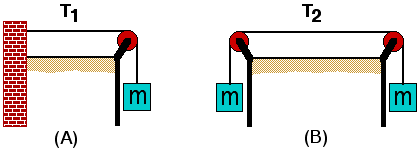A2L Item 045
- Description: Compare tensions when there is no motion.
- Goal: Reason using 2nd law.
- Source: UMPERG-ctqpe24
- Keywords: Interactions, Mechanics, Tension
The question for students:
Consider the two situations presented below. T1 is the tension in the string in case A and T2 is the tension in the string in case B.

Which of the following statements is correct?
- T1 < T2
- T1 = T2
- T1 > T2
- Cannot be determined
Commentary for teachers:
Answer
(2). The force exerted on each block by the attached string must balance the weight of the block. Since the blocks all weigh the same amount, the tension in the in the two strings must be equal.
Background
This item does not require formal knowledge of Newton’s Second Law. It can be used after students can identify the tension and gravitational force, provided they appreciate that for static situations the forces exerted on each object must balance. Try asking students to answer the question individually and without discussion, giving their initial reaction. Then ask students to re-answer the question after discussing it briefly in small groups.
Students commonly think that T2 is greater than T1 because the rope in situation 2 “supports” two masses. This incorrect intuition can even exist in students who are capable of drawing correct free-body diagrams and who know that the “tension” force exerted on each block must balance the weight of the block. The coexistence of conflicting intuition and formal knowledge is common among novices.
Questions to Reveal Student Reasoning
What is tension? How do you measure tension?
For situation (A) consider placing a spring scale between the string and the block in the vertical region. What force is the spring scale measuring? For situation (A) consider cutting the string in the middle of the horizontal region and inserting a spring scale. What force is this spring scale measuring? How would the readings on the two spring scales compare?
If spring scales were placed similarly in situation (B), how would their readings compare to the readings on the spring scales in situation (A)?
Suggestions
Consider the original situations and two variations: (a) In (A) consider a person holding the string in place of the wall; (b) In (B) consider a person holding the string in place of the block on the left. In each situation, what force is being exerted on the string so that the hanging mass at the other end does not move?
Set up the two situations depicted in the item. Insert spring scales at appropriate points. Discuss the readings on the scales.